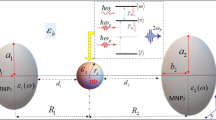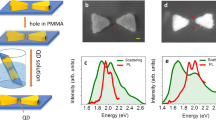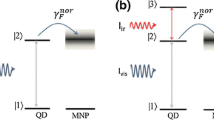Abstract
We simulate the dynamics of a quantum dot coupled to the single resonating mode of a metal nanoparticle. Systems like this are known as metamolecules. In this study, we consider a time-dependent driving field acting onto the metamolecule. We use the Heisenberg equations of motion for the entire system, while representing the resonating mode in Wigner phase space. A time-dependent basis is adopted for the quantum dot. We integrate the dynamics of the metamolecule for a range of coupling strengths between the quantum dot and the driving field, while restricting the coupling between the quantum dot and the resonant mode to weak values. By monitoring the average of the time variation in the energy of the metamolecule model, as well as the coherence and the population difference in the quantum dot, we observe distinct nonlinear behavior in the case of strong coupling to the driving field.




Similar content being viewed by others
References
Tame MF, McEnery KR, Özdemir SK, Lee J, Maier SA, Kim MS (2013) Nat Phys 9:329
Chen X, Li S, Xue C, Banholzer MJ, Schatz GC, Mirkin CA (2009) ACS Nano 3:87
Zuloaga J, Prodan E, Nordlander P (2010) ACS Nano 4:5269
Marinica DC, Kazansky AK, Nordlander P, Aizpurua J, Borisov AG (2012) Nano Lett 12:1333
Bouillard JG, Dickson W, O’Connor DP, Wurtz GA, Zayats AV (2012) Nano Lett 12:1561
Valentine J, Zhang S, Zentgraf T, Ulin-Avila E, Genov DA, Bartal G, Zhang X (2008) Nature 455:376
Pratibha R, Park K, Smalyukh II, Park W (2009) Opt Express 17:19459
Leonhardt U (2007) Nat Photon 1:207
Kelly KL, Coronado E, Zhao LL, Schatz GC (2003) J Phys Chem B 107:668
Lal S, Link S, Halas NJ (2007) Nat Photon 1:641
Nehl CL, Hafner JH (2008) J Mater Chem 18:2415
Pelton M, Aizpurua J, Bryant G (2008) Laser Photon Rev 2:136
Ridolfo A, Di Stefano O, Fina N, Saija R, Savasta S (2010) Phys Rev Lett 105:263601
McEnery KR, Tame MS, Maier SA, Kim MS (2014) Phys Rev A 89:013822
Makarov DE, Makri N (1994) Chem Phys Lett 221:482
McLachlan AD (1964) Mol Phys 8:39
Tully JC, Preston RK (1971) J Chem Phys 55:562
Miller WH, George FF (1972) J Chem Phys 56:5637
Pechukas P (1969) Phys Rev 181:166
Pechukas P (1969) Phys Rev 174:166
Heller EJ, Segev B, Sergeev AV (2002) J Phys Chem B 106:8471
Shenvi N (2009) J Chem Phys 130:124177
Aleksandrov IV (1981) Z Nat Forsch A 36:902
Gerasimenko VI (1982) Teor Mat Fiz 150:7
Boucher W, Traschen J (1988) Phys Rev D 37:3522
Zhang WY, Balescu R (1988) J Plasma Phys 40:199
Balescu R, Zhang WY (1988) J Plasma Phys 40:215
Osborn TA, Kondrat’eva MF, Tabisz GC, McQuarrie BR (1999) J Phys A Math Gen 32:4149
Kapral R, Ciccotti G (1999) J Chem Phys 110:8919
Sergi A, MacKernan D, Ciccotti G, Kapral R (2003) Theor Chem Acc 110:49
Sergi A, Petruccione F (2010) Phys Rev E 81:032101
Uken DA, Sergi A, Petruccione F (2011) Phys Scr T143:014024
Uken DA, Sergi A, Petruccione F (2013) Phys Rev E 88:033301
Sergi A, Sinayskiy I, Petruccione F (2009) Phys Rev A 80:012108
Breuer HP, Petruccione F (2002) The theory of open quantum systems. Oxford University Press, Oxford
Weiss U (2008) Quantum dissipative systems. World Scientific, Singapore
Gerry CC, Knight P (2004) Introductory Quantum Optics. Cambridge University Press, Cambridge
Goldstein H (1980) Classical mechanics. Addison-Wesley, New York
Sergi A (2005) Phys Rev E 72:066125
Sergi A, Giaquinta P (2007) Phys Essays 20:629
Sergi A (2007) J Phys A Math Theor 40:F347
Horenko I, Schmidt B, Schuütte C (2001) J Chem Phys 115:5733
Shirley JH (1965) Phys Rev B 138:979
Zeldovich YB (1967) Sov Phys JETP 24:1006
Acknowledgments
We are grateful to Prof. Mark Tame for useful discussions and for stimulating our interest in quantum plasmonics.
Author information
Authors and Affiliations
Corresponding author
Additional information
This work is based upon research supported by the National Research Foundation of South Africa.
Appendices
Appendix 1: Adimensional coordinates and parameters
Upon indicating the dimensional coordinates and parameters with a prime, and introducing the energy scale \(\hbar \omega _{{\mathrm{a}}}'\), we have the following definitions:
The symbol M is the inertial parameter of the oscillator, which has been set to unity. Upon choosing \(\omega _{{\mathrm{a}}}'\) in such a way that the frequency \(\omega =0.5\) of the oscillator in Eq. (16) corresponds to the value \(\omega '=8.9 \times 10^{12}\) Hz, which is typical for the dynamics of metal nanoparticles [14], we obtain a spanned timescale in our simulations of \(5.62 \times 10^{-12}\) s and an energy variation for the quantum dot, as shown in Fig. 4, of 24.6 meV.
Appendix 2: Phase-space-grid algorithm
The equation of the density matrix in the partial Wigner representation is analogous to that given in Eq. (4):
Using the basis defined by \(\hat{H}_{{\mathrm{S}}}|\alpha \rangle = \epsilon _{\alpha } |\alpha \rangle\) (\(\alpha =1,2\)), Eq. (35) can be written as
where the frequency \(\tilde{\omega }_{\alpha \alpha '} = \left( \epsilon _{\alpha } - \epsilon _{\alpha '}\right) /\hbar\) has been defined. The Liouville operator, L, is given by
One can introduce the following frequencies \(\tilde{\omega }^{\alpha \alpha '}\):
The equations of motion for matrix elements of the density operator can be written explicitly as:
In order to simplify the integration, one can use the definition
Hence, using dimensionless coordinates, the equations of motion become
Equations (43), (44), (45), and (46) describe a set of coupled partial differential equations (PDE’s) which can be solved to obtain the elements of the density matrix as functions of time. In order to solve these coupled PDEs, the numerical integration approach known as the method of lines can be employed. The method of lines transforms the PDEs into a set of ordinary differential equations (ODEs) by using finite difference approximations for all but one of the integration variables. In this case, the phase-space derivatives are approximated, while the time variable is left un-approximated. For the types of potentials studied in this work, a fourth-order finite difference approximation for the phase-space derivatives proves to be more than sufficient:
Once the conversion from PDEs to ODEs has been performed, a numerical integration method can be utilized. In this work, a Runge-Kutta 5 Cash–Karp method was found to be suitable for stable numerical results. In such an approach, the phase space of the system is essentially discretized into a numerical grid, upon which the coupled ODEs are solved.
Rights and permissions
About this article
Cite this article
Uken, D.A., Sergi, A. Quantum dynamics of a plasmonic metamolecule with a time-dependent driving. Theor Chem Acc 134, 141 (2015). https://doi.org/10.1007/s00214-015-1749-9
Received:
Accepted:
Published:
DOI: https://doi.org/10.1007/s00214-015-1749-9




